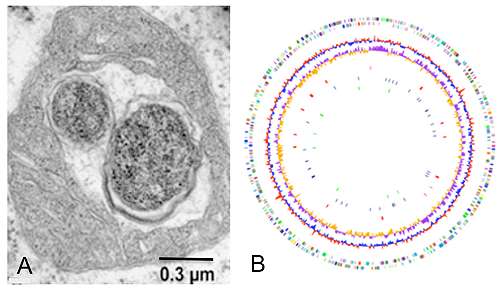Star Wars-inspired bacterium provides glimpse into life

(PhysOrg.com) -- A bacterium whose name was inspired by the Star Wars films has provided new clues into the evolution of our own cells and how they came to possess the vital energy-producing units called mitochondria.
The University of Sydney research investigated the bacterium Midichloria mitochondrii- named after helpful Star Wars microbes, called Midi-chlorians, that live inside cells and grant the mystical power known as The Force. It has revealed that mitochondria may have entered our cells though a parasitic bacterium that used a tail to swim and could survive with almost no oxygen.
The work, published in this month's issue of Molecular Biology and Evolution, challenges traditional explanations of how the ancestors of mitochondria first entered our cells between one and a half and two billion years ago. It also sheds new light on a process recognized as one of the major transitions in the history of life on earth.
"Our results challenge the paradigm - shown in every biology textbook - that mitochondria were passive bacteria gobbled up by a primordial cell," says co-author Dr. Nathan Lo from the University of Sydney's School of Biological Sciences.
"We have found instead that the mitochondrial ancestor most likely had a flagellum, so was able to move, and possibly acted as a parasite, rather than prey, on early eukaryotic cells," added Dr. Lo, who collaborated with scientists from Italy and Spain on the research.
Eukaryotes include all forms of animal and plant life on earth that are more complex than bacteria. They differ from simpler life forms because their cells have both a nucleus and mitochondria, which are like little batteries that generate energy to power the cell.
"How eukaryotic cells evolved remains one of the most vexing problems in biology," said Dr. Lo.
"Mitochondria are actually highly reduced bacteria, with their own set of DNA, that reside in our cells. It has long been thought that this relationship developed when an ancient eukaryotic cell engulfed the mitochondrial ancestor.
"But there is still mystery around the question of how exactly the mitochondrial ancestor was engulfed, and how it survived in the oxygen-poor atmosphere of early eukaryotic life."
For clues Dr. Lo and collaborators studied Midichloria mitochondrii- a bacterium they discovered in 2004 and successfully obtained permission from director George Lucas to name after the Star Wars Midi-chlorians. M. mitochondrii is from the Rickettsiales family, considered to be the closest living relatives of the ancestor of mitochondria.
"We studied M. mitochondrii because its genome has never been analysed and because it is the only bacterium known to be able to enter into the mitochondria of living cells," said Dr. Lo.
After determining the DNA sequence of M. mitochondrii's entire genome, Dr. Lo and collaborators found the bacterium contained 26 genes coding for an entire flagellum - including all the key components such as hook, filament and basal body.
He also found a second set of genes which coded for enzymes that would allow the bacterium to survive in low-oxygen environments. These genes have never been seen before in bacterial relatives of mitochondria.
Dr. Lo says: "We found these two sets of genes were inherited from the common ancestor shared by M. mitochondrii and our own mitochondria. Mitochondria's ancestor most likely possessed a flagellum, which is a key characteristic of many parasitic bacteria.
"Our results show the ancestor of mitochondria probably played a much more active, even parasitic, role in the early interactions with its eukaryotic host than previously thought. They also explain how the relationship could have evolved in the low-oxygen environments of two billion years ago.
"This should cause a rethink of how the symbiosis between mitochondria and eukaryotic cells originally developed - one of the most controversial topics in biology."
Provided by University of Sydney
















